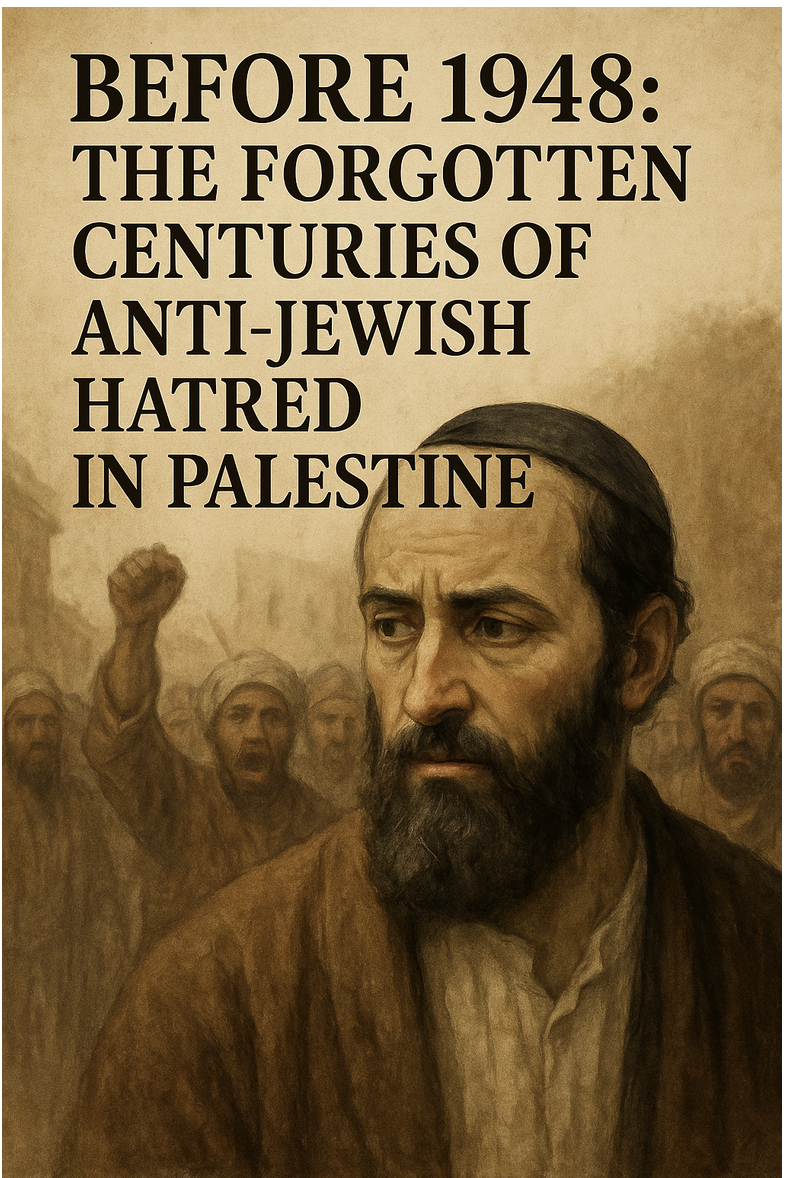

By Dr. Tim Orr
Picture yourself in the bustling hills of Sfat in 1834, a spiritual hub for Jewish mysticism in Ottoman-controlled Palestine. You’re part of the old Yishuv—Jewish families who have lived in the land for generations, long before Zionism was even a concept. You trade peacefully in the market, send your children to Torah study, and occasionally share meals or festivals with Arab neighbors. But then comes the chaos. A local revolt against Egyptian rule spirals into targeted violence against the Jewish quarter. Homes are ransacked, Torah scrolls burned, and women assaulted. Israel Bak, who operated the region’s first Hebrew printing press, watches his life’s work reduced to ash. This wasn’t a political uprising against settlers or soldiers; it was a pogrom against Jews for being Jews—a pattern that long predates 1948 (J-TV+, 2025; Morris, 2001).
The narrative that antisemitism in Palestine began with the founding of the State of Israel is not only historically inaccurate—it’s morally negligent. Long before Herzl convened the First Zionist Congress in 1897, and even before modern Jewish immigration to Palestine, Jews lived under a system of dhimmitude that rendered them second-class citizens. Under Islamic law, dhimmis were protected, but humiliated: required to pay the jizya tax, barred from public office, and often forced to wear distinguishing clothing or walk barefoot in Muslim quarters (Lewis, 1986). While some rulers were more tolerant than others, the underlying theological tension remained. The memory of Muhammad’s clashes with the Jewish tribes of Medina—especially the mass execution of the Banu Qurayza—fueled centuries of Islamic antisemitism (Ibn Hisham, trans. Guillaume, 1955). Passages in the Qur’an, such as Surah 5:82, which describes Jews as the “most hostile” to Muslims, further embedded these sentiments into cultural memory.
The pogroms and persecutions were not isolated to Arabia or even the early Islamic period. In 1066, Granada witnessed the massacre of 4,000 Jews when jealousy over a Jewish vizier’s influence triggered a riot. In 1033, a large number of Jews—possibly up to 6,000—were killed in Fes, Morocco. However, some historians debate the accuracy of this figure and suggest lower estimates based on available evidence. Baghdad’s Jewish population faced forced labor and beatings during tax collection in the Abbasid era. Historian Bernard Lewis (1984) observed that while Jewish communities could thrive under Islamic rule, they were always vulnerable to theological resentment, political instability, and economic envy. The precariousness of Jewish life was normalized: periods of peace were the exception, not the rule. And so, when these dynamics played out in Palestine, they were not anomalies—they were local manifestations of a larger, entrenched hostility (J-TV+, 2025).
In the 19th century, Palestine’s Jewish community—still small and largely non-Zionist—continued to face violence. Another attack followed the 1834 pogrom in Sfat in 1838. Rioters beat Rabbi Avraham Dov Bear and destroyed his sacred library. In 1847, Jews in Jerusalem were accused of killing a Muslim child in a blood libel borrowed from European Christian traditions, and a Jewish merchant’s shop was burned before he was exonerated. Tiberias saw similar violence in 1851 during a local Arab feud (Parfitt, 1987). These incidents occurred decades before large-scale Jewish immigration began. Most of these Jewish victims had no political aims, no ambitions of statehood—they were religious minorities living amid instability. Their targeting stemmed not from nationalism, but from deeply rooted religious prejudice and centuries-old narratives portraying Jews as untrustworthy or cursed.
By the early 20th century, modern Zionism introduced new dynamics to the region, but the old hatreds didn’t disappear—they adapted. The arrival of Jewish immigrants who bought land legally and introduced economic development was met with growing suspicion. Arab elites and Islamic clerics, long accustomed to Jewish subservience, now saw Jews asserting autonomy. Compounding this, antisemitic literature like The Protocols of the Elders of Zion was translated into Arabic and spread widely, fueling conspiracies about Jewish domination (Katz, 1980). When the Grand Mufti of Jerusalem, Haj Amin al-Husseini, rose to power, he masterfully fused theological and nationalist hatred. He incited mobs using Qur’anic rhetoric and later aligned himself with Hitler, recruiting Muslims for Nazi SS divisions during World War II. His rhetoric—citing Jews as enemies of Allah—revived medieval Islamic tropes and modernized them for nationalist purposes (Karsh, 2010).
The massacres of the 1920s and 1930s were not spontaneous eruptions of anger but orchestrated expressions of this deep-seated hatred. In 1920, six Jews were killed during the Nabi Musa riots in Jerusalem after inflammatory sermons encouraged bloodshed. In 1921, 47 Jews were murdered in Jaffa, including a young girl, Leah Goldberg, who was stabbed in her sleep. The most infamous pogrom occurred in Hebron in 1929, where 67 Jews—most of them non-Zionist—were killed by their neighbors. Still, this wave of violence also extended to other cities such as Sfat and Jerusalem, where additional Jewish communities were attacked and lives were lost. Of them, the non-Zionists were butchered by their neighbors. A student had his eyes gouged out; a baker was burned alive in his oven. These were not retaliatory acts against political aggressors but brutal executions of unarmed civilians (Mandel, 1976). Even then, not all Arabs joined the violence—19 Arab families in Hebron risked their lives to protect Jews—but their heroism was overshadowed by the majority who either participated in or enabled the massacres.
From 1920 to 1948, over 1,500 Jews were murdered in anti-Jewish riots across Palestine. These included six in Jerusalem in 1920, 47 in Jaffa in 1921, 67 in Hebron in 1929, and over 400 during the Arab Revolt of 1936–1939. These deaths preceded Israel’s founding and exposed the hollowness of the claim that antisemitism in Palestine only emerged with the Zionist movement. The Arab-Jewish conflict was not born in 1948—it is the modern eruption of a much older wound. As Jacob Lassner (2001) has argued, Jews were often viewed as eternal outsiders, and this perception was fueled not only by colonial dynamics but by Islamic memory and theology. Ignoring this long arc of hatred prevents us from understanding the present—and from seeking genuine reconciliation based on truth rather than myth.
Suppose we are to honor the victims of this historical hatred. In that case, women like Miriam Cohen hiding her children beneath the floorboards in 1834, or yeshiva students slain in Hebron—we must tell their stories honestly. They weren’t settlers or militants. They were targeted for their faith, their identity, and their presence in a land they had called home for centuries. Recognizing this does not deny Palestinian suffering. Rather, it ensures that justice isn’t built on a selective memory. Because if we forget what happened before 1948, we’ll never truly understand what’s happened since, and what still might come.
References
Ibn Hisham. (1955). The Life of Muhammad (A. Guillaume, Trans.). Oxford University Press.
J-TV+. (2025). Antisemitism Before Israel: It was Never about Zionism [Documentary].
Karsh, E. (2010). Palestine Betrayed. Yale University Press.
Katz, J. (1980). From Prejudice to Destruction: Anti-Semitism, 1700–1933. Harvard University Press.
Lassner, J. (2001). Jews, Christians, and the Abode of Islam: Modern Scholarship, Medieval Realities. University of Chicago Press.
Lewis, B. (1984). The Jews of Islam. Princeton University Press.
Lewis, B. (1986). Semites and Anti-Semites: An Inquiry into Conflict and Prejudice. W.W. Norton.
Mandel, N. (1976). The Arabs and Zionism Before World War I. University of California Press.
Morris, B. (2001). Righteous Victims: A History of the Zionist-Arab Conflict, 1881–2001. Vintage.
Parfitt, T. (1987). The Jews in Palestine 1800–1882. Royal Historical Society.
Who is Dr. Tim Orr?
Tim serves full-time with Crescent Project as the assistant director of the internship program and area coordinator, where he is also deeply involved in outreach across the UK. A scholar of Islam, Evangelical minister, conference speaker, and interfaith consultant, Tim brings over 30 years of experience in cross-cultural ministry. He holds six academic degrees, including a Doctor of Ministry from Liberty University and a Master’s in Islamic Studies from the Islamic College in London.
In addition to his ministry work, Tim is a research associate with the Congregations and Polarization Project at the Center for the Study of Religion and American Culture at Indiana University Indianapolis. His research interests include Islamic antisemitism, American Evangelicalism, and Islamic feminism. He has spoken at leading universities and mosques throughout the UK, including Oxford University, Imperial College London, and the University of Tehran. He has published in peer-reviewed Islamic academic journals. Tim is also the author of four books.
